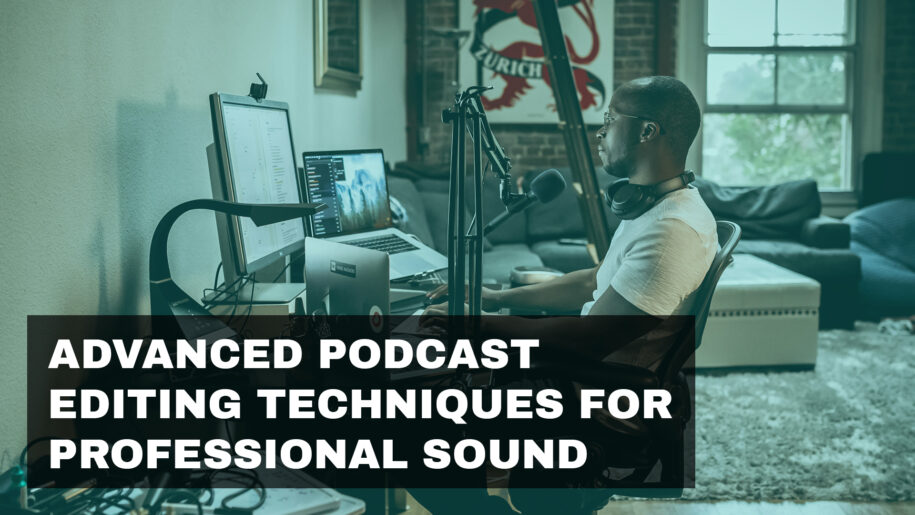Creating a podcast involves more than just recording audio; it requires meticulous editing to ensure a polished, professional sound. Advanced editing techniques can significantly enhance the quality of your podcast, making it more engaging and enjoyable for your listeners. In this post, we’ll explore various advanced podcast editing techniques that can help you achieve a professional sound.
1. Noise Reduction
Even with a high-quality microphone, unwanted background noise can creep into your recordings. Advanced noise reduction techniques help eliminate these distractions:
Using Noise Gates: A noise gate allows audio signals above a certain threshold to pass through while muting anything below that level. This helps in cutting out low-level background noise during pauses in speech.
Spectral Editing: Advanced audio editors like Adobe Audition offer spectral editing, which allows you to visually identify and remove specific noise frequencies. This technique is highly effective for removing persistent background noises like hums or hisses.
2. Equalization (EQ)
Equalization adjusts the balance of different frequency components in an audio signal. Proper EQ can make your voice sound clearer and more natural:
High-Pass Filter: Applying a high-pass filter can remove low-frequency rumble or hum, typically anything below 80-100 Hz.
Midrange Boost: Enhancing the midrange frequencies (around 1-4 kHz) can make vocals more intelligible and present.
De-Essing: This technique reduces harsh “s” sounds by attenuating the high frequencies where these sounds occur, usually around 5-10 kHz.
3. Compression
Compression evens out the dynamic range of your audio, making soft sounds louder and loud sounds softer. This ensures a consistent volume level throughout your podcast:
Threshold and Ratio: Set the threshold to the level where you want compression to start, and adjust the ratio to control the amount of compression. For podcasts, a ratio of 3:1 or 4:1 is usually effective.
Attack and Release: The attack time determines how quickly the compressor responds to loud sounds, while the release time dictates how quickly it stops compressing. Fast attack and moderate release times work well for spoken word content.
4. Using Effects
Effects can enhance the overall sound quality and add a professional touch to your podcast:
Reverb: Adding a subtle reverb can create a sense of space and depth. However, use it sparingly to avoid making the audio sound too distant or echoey.
Panning: Panning can be used to position sounds within the stereo field. For interviews, placing each speaker slightly off-center can create a more immersive listening experience.
Limiter: A limiter ensures that the audio doesn’t peak above a certain level, preventing distortion. It’s particularly useful for maintaining a consistent output level.
5. Editing Speech
Editing speech involves more than just cutting out mistakes. It includes refining the flow and clarity of your podcast:
Removing Filler Words: Cut out unnecessary filler words like “um,” “uh,” and “you know” to make the dialogue more concise and professional.
Tightening Pauses: Reduce excessive pauses between sentences or thoughts to maintain a smooth and engaging pace.
Crossfades: Use crossfades to smooth out abrupt edits and transitions, ensuring seamless audio flow.
6. Advanced Mixing Techniques
Mixing involves balancing all the audio elements in your podcast, including voice, music, and sound effects:
Volume Automation: Use volume automation to adjust levels throughout the podcast. This ensures that the narration, interviews, and background music are all balanced properly.
Sidechain Compression: Apply sidechain compression to background music, making it duck slightly when speech is present. This keeps the music from overpowering the vocals.
Binaural Panning: For a more immersive experience, consider using binaural panning to position sounds in a three-dimensional space, especially if your podcast includes field recordings or ambient sounds.
Advanced podcast editing techniques can transform your recordings into professional-quality audio. By mastering noise reduction, equalization, compression, effects, speech editing, and mixing, you can produce podcasts that sound polished and engaging. These techniques require practice and a good ear, but the effort will pay off with a podcast that stands out in quality and professionalism. Happy editing!


